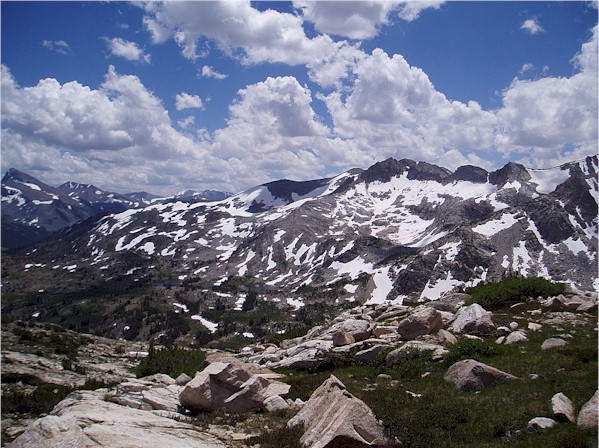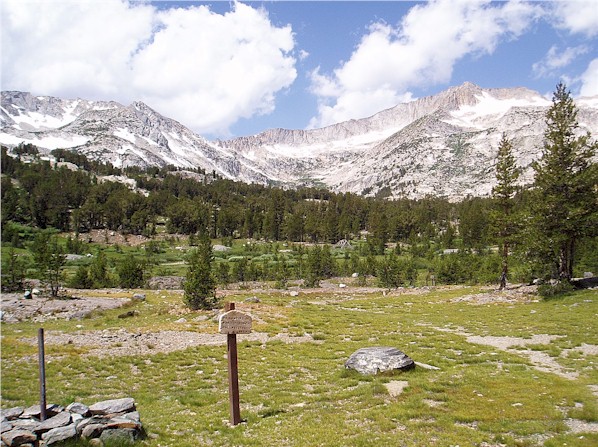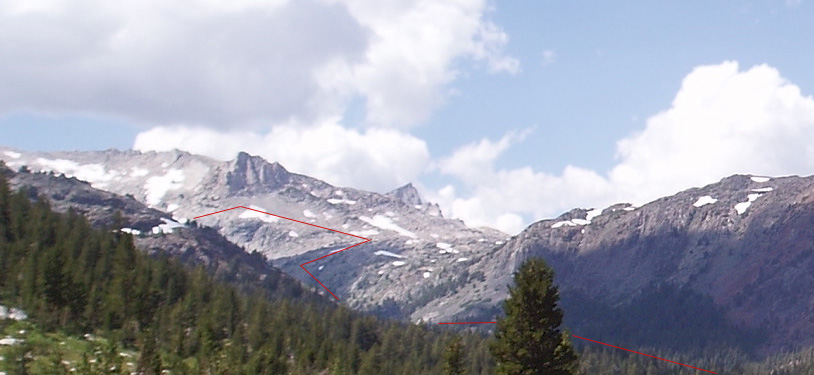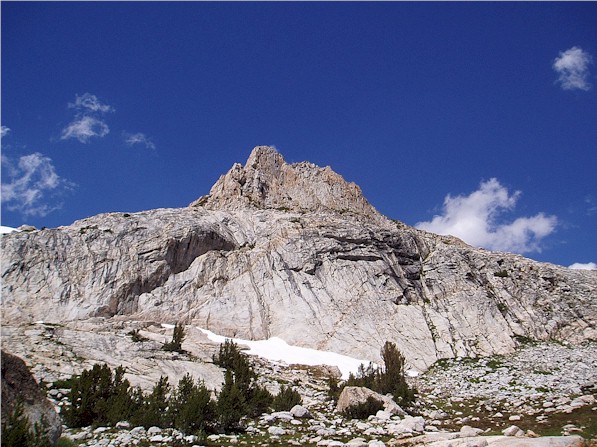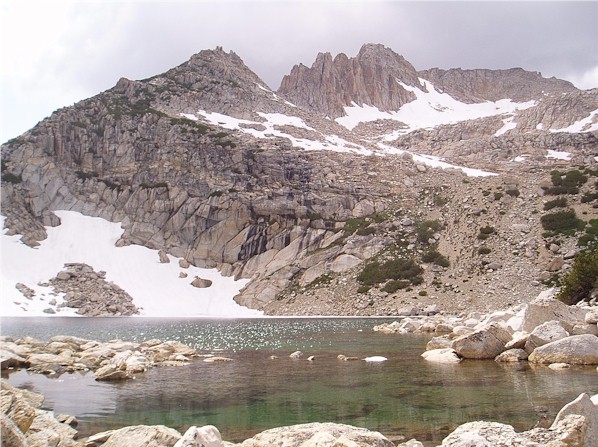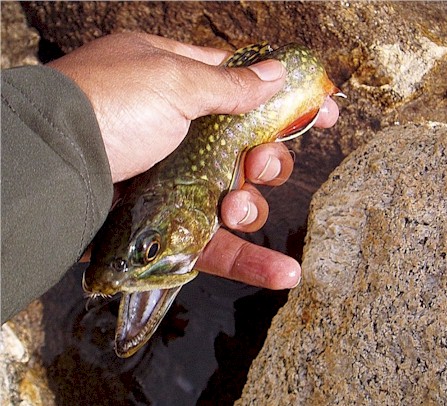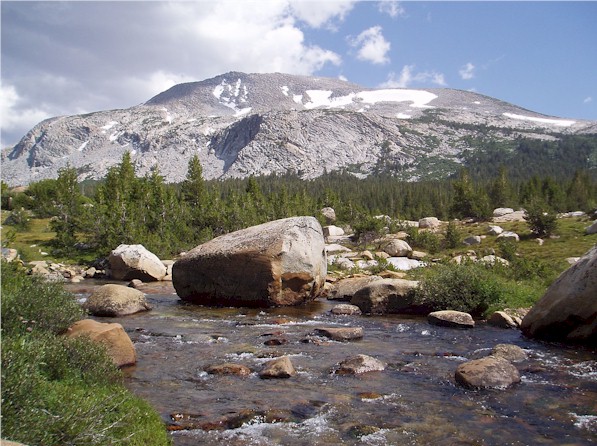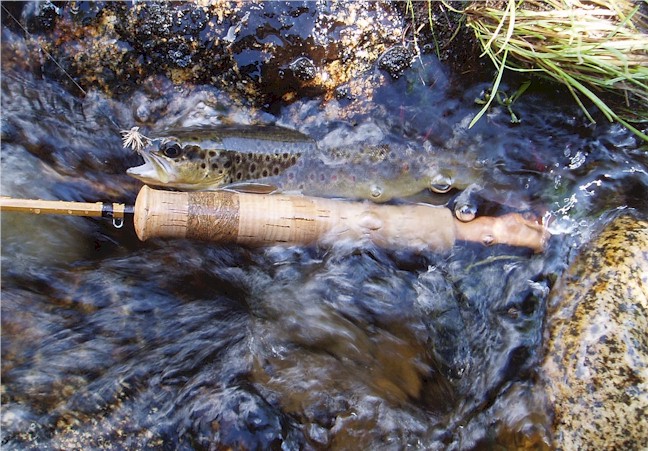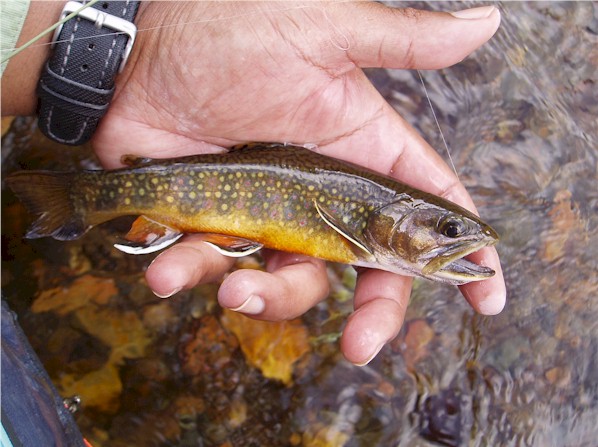|
|
|
|
|
August 4 & 5, 2006- Shepard Crest and Tioga Pass Time:
Late morning to Early Evening Narrative:
I was pretty excited about this trip. Iíd get to fish Friday and Saturday instead of my normal Saturday and Sunday. I envisioned beating the crowds; Iíve never been able to get a camp site at one of the high Tioga Pass or Saddlebag Lake campgrounds and I thought Iíd get one this time for sure. In the past when fishing Saddlebag Lake, Iíve slept in my car and never ďcampedĒ in the same spot twice. This weekend I wanted to have a base of operations. I wanted to set my tent up in a campground, have all my gear laid out and have some place to crash after fishing. That didnít happen and that small occurrence would change the flavor of the entire weekend. In the past when fishing in this area, Iíve literally driven around for an hour checking all the near by campsites to no avail. I didnít want to do that this time around and when I drove through both the Saddlebag Lake and Ellery Lake campgrounds and found them full, I didnít hesitate. I headed straight for Mammoth Lakes and the Shilo Inn. By doing so, this trip would lose its hardcore edge but that was ok. I'd have my all important base of operations. If I was going to stay 45 min from my fishing destination, I might as well be comfortable. I had originally planned to fish an unnamed lake in the Tioga Ė Shepard Crest area. Iíd also read of an alpine Golden Trout lake below Mt. Conness on a tough, off trail route. If time allowed, II'd fish the first and then make the cross country jaunt to the second. This would be followed the next day by a trip into the 20 Lakes Basin to fish Odell and Helen Lakes as well as Mill Creek.
I arrived at the Saddlebag Lake Resort to find the place packed. I was surprised. It was Friday and the place was more crowded than I had ever seen it. I sat down at the breakfast bar and listened to the various conversations the Resort staff were having. It seems that by 9am on this particular Friday, all the shuttle spots were taken until late, late morning. Most of the folks were first timers; there was a group from the South Bay, as well as a family with a distinctly southern drawl. In nothing but shorts and T-shirts, the southern family was ill prepared for an afternoon in the High Sierra, especially on this day but more on that later. I ate my breakfast and picked up two of the silver Barbier books they had in stock before heading to the trailhead. I took my time getting my gear together and decided to make the decision on which lake to fish once I was on the trail. Or, more appropriately, once I left the trail. There would be no trail to either lake after the first mile or so. I had one older fellow laugh when I told him where I was going, telling me that I was on the wrong side of the mountain and needed to be over by Tioga Lake. I explained that I was planning to take the back way into the lake, with a possible side trip to the alpine lake. He shrugged his shoulders in sort of a ďsuit yourselfĒ gesture.
The trail was fairly easy until it arrived at an old research center which was in disrepair. The map showed that the trail ended here but in truth it continued to the base of the climb up to the alpine lake. This is where I made my decision to fish the alpine lake and not the unnamed lake. The pull of an unknown golden trout lake was too great and thus began my 2 hour adventure to find it. I had a pretty good idea where the lake was based on the map, about a mile and a half away and over a 1,000 feet higher than my current position; but the map was not the terrain. It was obvious to me that the lake was behind a bluff directly in front of me so I made my way straight up until I could get a better view of the terrain. The mosquitoes were horrible. I'm convinced that "mosquito" is Spanish for "Devil Bug". I was above 10,000 feet and there was still quite a bit of snow, the melting snow kept the small patches of tundra wet and presumably kept the mosquito population high. I have one of those ďbug offĒ shirts from Orvis and the only thing it did was provide the mosquitoes a nice resting place before deciding to attack some other part of my flesh. I also have an electronic device which is supposed to imitate a male mosquito in heat and therefore keep the biting females away- as Iíve reported before, it doesnít work. Finally, I decided to put on some bug spray. Iíve got some of that new stuff from Europe called Picardin. It works pretty well at stopping the bugs from biting but you have to be completely covered and it doesnít stop the bugs from swarming. If you miss a spot, the bugs find it. I longed for the 6 inch ďforce fieldĒ you get with a good spreading of Jungle Juice, REI's 100% deet repellant.
I decided to make my way up and to the right of the bluff. A fellow I talked with on the trail gave me the impression that the lake would be on the right side and there was a saddle on the far right, from which I hoped to get a good view of the Twenty Lakes Basin. The route proved to be a little more challenging than I had anticipated. The saddle was a wide one and didnít offer any views from where I was standing. I had to traverse a precarious rock fall and snow field. The rocks were large and loose and I made sure to place my hands and feet carefully, lest a rock shift and trap an appendage or worse, my entire body. The snow field was the hairy bit of the traverse. Steeper and larger than I initially thought, the snowfield was covering the same type of unstable rocks I had to cross to get to it. It however, would not let me test the rocks underneath, nor could I see if I would be crossing over any large gaps in the rocks which I could fall through. If I slipped on the snow and couldnít arrest myself, there was the prospect of falling over a 100 or so foot of near vertical granite. I wasnít too pleased with myself. It seemed like the sort of knuckle head move you read about in the outdoor adventure books were some guy does something sketchy and ends up crawling out of the wilderness using nothing but his pinky and big toe. I normally donít put myself in these sorts of situations, that is, unsafe situations. I weighed my options for a bit. I could go back or hike above the snowfield. Each of which would put me on this rock fall longer than I would like. It was the kind of place where any minute a loose rock could come tumbling down and take you with it. I wanted to get across and I wanted to get across now. I climbed to a spot where the snow field narrowed to about 15 or 20 feet. My first step was to a rock which was sticking out from the snow slightly. My next steps were firmly on the snow. I donít remember much but I do remember looking the distance I would slide down the snow before falling off the edge and mentally preparing to arrest myself should I fall. I made it over without incident and quickly made my way to the edge of the basin where I expected to find the lake. There was nothing; nothing but a small puddle, which was large enough to be a lake but too shallow to be anything other than snowmelt.
I checked my map, checked it again and checked it a third time. Then I checked my altimeter. My altimeter read 10,800ft. The position I had myself on the map had me at 11,300ft. Did I not climb high enough? I could see that there was probably a small basin 500 feet above me. Was the lake really there instead? I started to doubt my map reading skills. There was a small empty basin on the map but it appeared that it was a the same level as the lake and I presumed I should be able to see it from my current vantage point. I decided that the lake could only be one of two places- in the basin above me or in a hidden basin in front but below me. It could be either and I decided that after 2.5hrs, Iíd had enough climbing for the day. If I went any higher, I wouldnít have time to fish. It was time to make my way down and if I happened upon the lake, great, if not, Iíd fish the creek that the trail followed for much of its way. Getting down into the basin required
several ďleaps of faithĒ as I leaped from heights I couldnít climb down. On
the other side of the basin, I began to hear water flowing under the rocks,
perhaps the lake was above me still. I ran into two hikers aiming to bag on
of the two peaks above. I thought of asking if they knew where the lake was
but decided I wanted to find it for myself, some other day if I couldnít
today. I exchanged greetings with the hikers and headed down a steep rocky chute. I could hear and now see water trickling beneath rocks. I came upon the lake suddenly. One minute there was nothing and a few steps later I was looking in to an amazing dark blue basin. The view was amazing. There was still snow around much of the lake and some sections still had floating sheets of ice. As I made my way close to the lake, the rocks began to get larger. It was slow going over these larger rocks. But I finally made my way to the lake's edge. At the lake's edge I sat down to refuel. While eating I scanned the lake. The water was crystal clear and the deepest sapphire blue that you can imagine. There were no fish actively working in my area and no fish rising across the entire lake. The outlet was too dangerous to fish directly. Large rocks covered with snow went directly up to the waters edge. There was no way of knowing whether you were standing on rock or over an air pocket above the lake itself. There was a shelf of ice floating close by so I decided to fish that first. Iíve always read that fish like to hang out underneath such ice and ambush prey, though Iíve never experienced this myself. I started by casting a Stillwater Nymph with a Diawl Bach dropper. The Diawl Bach, literally "little devil" in Welch, is a British lake fly which Iíve decided to try this year. Itís a simple stick fly of peacock and brown furnace hackle. I made several casts every foot or so along the length of the ice and several casts to several depths at each spot. No interest. I decided to walk the banks looking for cruising fish. This was challenging due to the irregular nature of the shore side. Itís hard to be stealthy as you go up and around, back and forth along the shore side.
I found one cruising fish and made a cast to intercept it as it swam leisurely above deeper water. The crash and splash of my fly sent the fish running for cover and it didnít come back. This would happen several times this day, even when I switched to dry flies, the motion of the rod initiating the cast would send fish in all directions. I suspect these fish might have been golden trout. Shortly after this, some fish started working in the shallower water by the outlet. There was another type of fish which I suspect was not as put off by my casting and thus perhaps the only type I caught. That would be the brook trout. When the wind died down a few fish started working the surface. There was one that was deliberately working the shoreline and within casting range. I fumbled to change my wet fly and sinking leader to a dry fly and floating leader. A few casts later and I was into my first fish- a 6 inch Brook Trout. I tried several different flies but none seemed to work as consistently, with wind and without wind as my old standby, the cripple caddis. I continued working the shoreline, targeting fish when I could and casting blindly when I could not. I was catching smallish brook trout- 6 and 7 inches. I knew there were supposed to be 8 and 10 inch fish in this lake but so far I hadnít come across any. In a small cove near the outlet a spotted a large fish, it was resting, motionlessly between some rocks. Afraid of spooking it, I deliberately made a short cast. At first I thought it was too short but when I noticed the fish had moved, I let the fly sit and soon the water around it exploded. I set the hook and quickly landed a very stunted brookie.
I only caught Brook Trout. There were supposed to be Brook and Golden Trout in this lake. Itís possible the Brook Trout have pushed out the Goldens but I canít help thinking about those super spooky fish cruising in pods that I seemed to keep spooking. I didn't catch any of those fish and they could have been Goldens. Time went quickly and before I knew it, it was 4:00pm. 4:00pm was my planned down time but Iíd barely fished 1/5th of the lake. I was contemplating staying until 4:30pm when it started to snow heavy ice crystals. I was filtering some water for the trip down when WHACK! A lighting bolt flashed across the sky followed by a loud rumble.
Time to leave. From the outlet, I could make my way down more quickly than the way I had come. Unfortunately, not having come up this way, I didnít know the best place to descend. From my vantage point, all I could see were giant granite slabs, large rocks, brush, water and a very steep drop to the valley floor. Working down the outlet stream was too risky. I couldnít see if the stream came to any shear drops anywhere. As a was contemplating my route, a bolt of lightning struck trees not far from where I had made my first stream crossing earlier in the day. I decided the lesser of two evils was to work my way down the graniteÖÖas quickly as possible. Through a series of lateral traverses, jumps and slides, I made my way to a less step portion of the decent. From there, I made my way at a running pace down to a small batch of trees, jumping off short ledges and ramming my leg bone into my hip socket several times along way. At that first group of trees I made a decision. I could wait the storm out. Hope that I was low enough and sheltered enough to make it through or I could run the mile to the forest proper and take shelter in the old research station. I decided on the latter and so, like a fishing commando, I made my way from tree group to tree group, stopping to catch my breath and then sprinting in a crouched fashion to the next group of trees until I made the tree line. Once there I skirted the open meadow until I found the trail and then followed the trail as closely as I could without exposing myself.
I made it to shelter and shortly thereafter the lightning and thunder stopped. (The following week I took a better picture of The Route. Revising the area gave me a better perspective of what I'd done.) Lee Vining Creek and the Dana Fork On Saturday, I decided to nix my plans to fish Odell and Helen Lakes and fish something that would keep me closer to the car. Iíd never been in the middle of a high sierra storm before so far from shelter and with the forecast on Saturday, identical to Friday, I decided it would be more prudent to fish some road side streams. Iíd get in more fishing and not have to worry about the weather. As far as Iím concerned, my lighting dodging days are over. Saturday was lazy in comparison- almost boring. Iíd enjoyed fishing Lee Vining Creek last fall so I decided to give it another whirl. I parked the car at the big sandy lot on the way to Saddlebag and walked my way down stream to where the canyon started. I tied on a dry fly and made several casts to some very good looking water. After several more casts to equally good water along several yards of stream, with no results, I switched to a Darklord, GRHE dropper combination. With this, the fish started coming very quickly but they were planters and Iíd come to the Sierra for wild fish. Fishing for planter rainbows in the 12 to 16 inch class was hot but boring, almost predictable. Then I decided to challenge myself- to only fish to fish I could see. Itís amazing how much you learn when you do this. You realize just how quickly a fish can take and reject your fly. Soon I stopped setting the hook based on the movement of my leader (I was fishing without an indicator) and set the hook based on the motion of the fish. It was great fun watching my fly in the water or imagining my fly in the water and setting the hook when Iíd see a fish intercept it. At one point, I had a double- a fish on the point fly and on the dropper. It was only the second time thatís happened to me. The fishing slowed in the early afternoon and when the mosquitoes came out I decided to move to the Dana Fork of the Tuolumne. The Dana Fork is one of the most fished stream in Yosemite and with good reason, thereís good access from Dana Meadows, past itís confluence with the Lyell Fork all the way to the end of Tuolumne Meadows. Each year I see more and more cars parked along itís banks, which means more and more fisherman. Despite this, you can still find a little solitude and as I made my way past Dana Meadows, I decided to stop at a random pull out. The fishing was delightful. Small Brook and Brown Trout eagerly trounced on a well fished fly. Iím not a very good dry fly fisher on streams so I used the opportunity to practice getting a drag free float using different casts. Eventually I worried less about the trick casts and concentrated more on currents. Instead of trying to use a trick cast to get a good drift in tricky currents I simply concentrated on avoiding those currents all together. Effective and basic but I really would like to get those slack leader casts down. Again I fished various flies and determined that while the Brook Trout were more opportunistic than the Browns, they preferred mayflies and the Browns caddisflies. I fished two dry flies simultaneously and the Browns would only hit the caddis, while the Brooks would take both but take the mayfly more often. I fished my new Payne 97 7ft 4wt rod both days and would highly recommend the taper for anyone looking for a shortish, light trout rod. It's definitely my new favorite.
Previous Yosemite / Ansel Adams Wilderness Chronicle Next Yosemite / Ansel Adams Wilderness Chronicle
|

